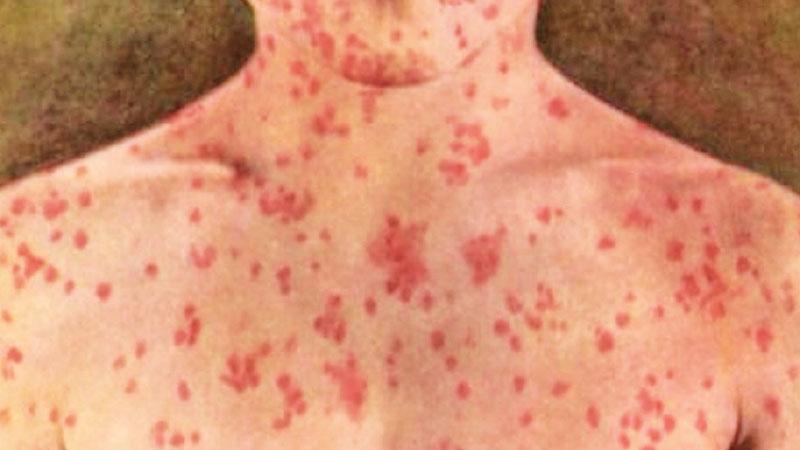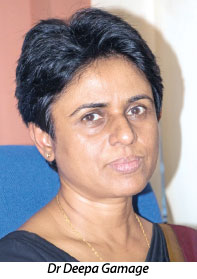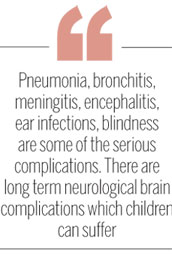
Measles is a highly infectious disease with fatal and serious complications. After the eradication of smallpox and leading the path for eradicating polio, the next possible disease for eradication would be measles in the world. The WHO in its strategies, identified measles to be eliminated by 2020. The six WHO-Regions in South East Asia, to which Sri Lanka belongs, are currently working tirelessly with 11 member countries towards that goal, despite facing obstacles on the way.

 The Sunday Observer talked to Senior Consultant Epidemiologist Dr Deepa Gamage of the Epidemiology Unit of the Health Ministry to find out what the current measles scenario was globally and in Sri Lanka, which were already on the verge of eliminating the disease, but are forced to face setbacks due to the unexpected re-emergence of the disease.
The Sunday Observer talked to Senior Consultant Epidemiologist Dr Deepa Gamage of the Epidemiology Unit of the Health Ministry to find out what the current measles scenario was globally and in Sri Lanka, which were already on the verge of eliminating the disease, but are forced to face setbacks due to the unexpected re-emergence of the disease.
Excepts …
Q. Measles has re-surfaced in several European countries, and in Japan, on the verge of eliminating the disease this year. What is the reason for outbreaks of measles cases in countries closer to elimination or even after being declared eliminated?
A. Measles is a highly contagious disease. It transmits from person to person, if a person does not have adequate immunity to protect himself from the disease. One infected person can transmit the disease to 16-18 persons who are not adequately immune to the disease.
Q. What is the measles situation in our country?
A. Sri Lanka was at a near elimination status by 2013, while an unexpected rising of measles cases have been experienced in 2013-2015 as an outbreak, with scattered cases throughout the country. During this outbreak, we have observed that the majority were infants, those before being given the first MMR dose and others were adults over 40 years, not protected by the measles vaccination.
However, the outbreak situation was controlled successfully by 2016 and there was only one confirmed measles case in 2017. Among the two cases we have identified in 2018, one has had a clear history of contact with a Chinese infected person, in China.
Q. Are they indigenous transmitted or by foreigners carrying the virus, who visit the country? If so how do we prevent a further outbreak.
A. At present, it seems indigenous transmission has been stopped in the country. This means, within the country, established transmission chains are no more there, but intermittent cases can be seen among measles unprotected individuals with global travels and risk exposures with contacts.
Q. How do we prevent a further outbreak?
A. There are no silent carriers of the virus i.e. carrying the virus without getting the disease. But, those who have got the infection can transmit it to others even before they show any signs or symptoms outside. This is the period of communicability of the disease. This time varies from four days before to four days after the signs and symptoms of measles. It means, the infected person with or without signs of the disease can transmit it to other susceptible persons.
Q. How is the disease transmitted?
A. Transmission from an infected to a non infected person is through airborne transmission where the infection enters through the susceptible person’s respiratory tract. If he/she does not have adequate protection, disease signs and symptoms will develop, usually after 14-21 days of the exposure. This is the incubation period of the disease in which the virus will grow inside the body and start spreading to others even before any signs of the disease.
Q. What are the distinctive signs and symptoms of measles?
A. Basic signs are fever, rash (which is called maculopapular rash), cough, runny nose, oral mucosal patches and reddish eyes. The main danger is that the virus can multiply inside the body if the person does not have adequate immunity. If not treated early it can lead to complications.
Q. If one gets fever, cough, a runny nose and red eyes, how do you differentiate it from an ordinary flu?
A. The ordinary flu is “seasonal influenza” which has similar signs and symptoms but maculopapular skin rash is unlikely in seasonal influenza. There are also other disease specific signs and symptoms. A medical doctor can identify measles.
However, it is important to report to a medical officer in a hospital and the Medical Officer of Health (MOH) of the area of the patient’s residence at the earliest. If any person has a suspicion of having measles, it is important to notify in the communicable disease surveillance system and to collect blood and respiratory tract samples for disease confirmation or exclusion as a national requirement in disease elimination in the country.
Q. What is the danger of getting measles?
A. Severe complications and death can occur. Pneumonia, bronchitis, meningitis, encephalitis, ear infections, blindness are some of the serious complications. There are long term neurological brain complications which children can suffer.
There are some risk factors like Immunodeficiency status, malnutrition, especially, Vitamin A deficiency can lead to severe complications. In addition, death can occur due to any of these complications.
Q. What do you consider as the key tool to protect oneself from this deadly disease?
A. The best way to be protected is through vaccination. The National Immunization Programme provides MMR vaccine to all children in the country. This includes protection for measles, and for rubella and mumps, as well.
It is important to give two doses of vaccine to children, the first dose at 9 months and the second dose at 3 years, to provide adequate protection from the disease. Every child in the country should get MMR vaccine for better protection. An unprotected child is considered as susceptible to contract the disease at any time in exposure.
Q. Studies show that the age of the victim has shifted, with more adults also getting measles. The most vulnerable ages according to WHO report is 0- 59 years. What is it in Sri Lanka?
A. Any age is vulnerable if no adequate protection has been taken. Younger age groups are vulnerable to severe complications of the disease and for mortality. Age group shifting is seen in countries due to strategies of vaccination programmes implemented in that particular country. Measles vaccination was started in 1984-85 in Sri Lanka and has expanded in scope considerably since then. Sri Lanka also experienced two situations of outbreaks of measles in 1999-2000 and 2013-2015. This underscores the fact that adequate protection needs to be maintained by achieving high coverage at all levels, aiming at elimination.
Q. Any new plans for elimination, such as, new guidelines, change of strategies and training of nurses?
A. Measles elimination guidelines are already updated to include strengthened strategies for early detection and reporting of “fever and maculopapular rash” by patients, strengthening vaccination, laboratory confirmation of all “fever and maculopapular rash” patients. All medical staff in Medical, Paediatric wards, outpatient departments and MOH offices are informed and made aware of these new guidelines of achieving zero indigenous measles cases in the country. Trainer programmes have been conducted for all public health staff and relevant officers from hospitals on the new guidelines during 2017-2018.
Q. Who is responsible and involved in monitoring the achievements of the elimination target in the country?
A. This is a collective responsibility of different parties of the Ministry of Health and also the private health sector. The Epidemiology Unit in the Ministry of Health has the overall responsibility for the National Measles, Rubella Elimination Programme in Sri Lanka, policy implementation, monitoring and evaluation for both, the National Immunization programme and the communicable disease surveillance system.
Service delivery in identifying suspected measles cases early, notifying, laboratory investigation and provision of vaccination are carried out by the hospitals and public health staff at MOH offices who receive technical guidance from district level Regional Epidemiologists and provincial level Consultant Community Physicians, together with the staff of the Central Epidemiology Unit. Laboratory confirmation is ensured through testing samples at National accredited virology laboratory in the Medical Research Institute.
Q. Your message to the public on 1) Prevention – via immunisation 2) Precautions and treatment?
A. All children should be vaccinated age appropriately, i.e. at the age of 9 months for the first dose of MMR and at 3 years for the second dose of MMR for adequate protection from measles. This will prevent disease transmission, complications, long term disabilities and deaths of children under 5 years.
All those with fever and reddish maculopapular skin rash should see a medical officer at the earliest for laboratory confirmation, relevant notifications and for adequate treatment for the person affected, as well as for further prevention of disease transmission in the community.
